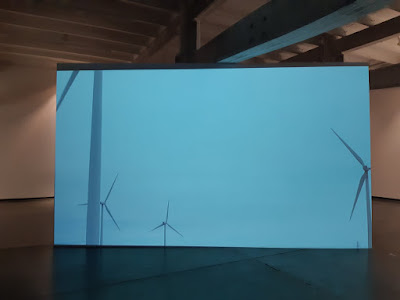published in Art India
Vol. 23 / Issue 1 / Apr 2019
The Production of Ambiguity
Raqs Media Collective’s show invites us to doubt our political and social bearings while revisiting George Orwell’s life, points out
Anuj Daga.
The 3D-printed burnt biscuits individually encased and displayed on the French table at the Raqs Media Collective’s show
Provisions at Project 88, Mumbai, from the 16th of January to the 9th of March, sharply comment on the French army’s trial accounts of the Paris Communards. The Paris Commune was a short-lived radical socialist and revolutionary government composed of the working class that ruled Paris for two months in 1871. Later, 20,000 of these workers were said to have been imprisoned in ‘hermetically closed’ cattle wagon-like pontoons with no sign of fresh air, thrown upon a heap of biscuits that reduced to crumbs under them. The prisoners in the dungeons ashore survived only on crumbs of biscuits and rancid fat.
In a continual reading, the lenticular prints
To Ask When Empty mounted alongside on the wall seem to express the disorientation of those tortured prisoners. However, in a more general sense, the shifting illusory impressions of verb couplings like ‘To Disobey/When Told’ or ‘To Feed/When Hungry’ jeopardize quotidian causality. They invite the mind to flicker in their stereoscopic bracing of everyday tasks. How is eating/feeding and hunger controlled? When does one pour/ask into the empty/full glass? The variable relationships between cause and effect perceived in the lenticular shimmer as we move across space and time induce skepticism and prepare us to dive into a pool of doubt.
Palimpsests of perforated sheets in varied materials talk of toxicity, and ask if, humanity in the spirit of equity, may share contamination too. How does one map the distribution of decay and pollution, disease and contagion? How does pain overlap life-forms, and what kind of possibilities emerge between them? On another wall, a fictitious conversation between workers and robots in a factory canteen leads us into questions about humanity being reconstituted vis-a-vis artificial intelligence. Narrated in ten screen-printed newsprint panels that embody the act and materiality of labour and mass production, the story simultaneously reveals the inner mechanized lives of workers in confrontation with the enlivening agencies of robots. Over a short conversation, the worker and the robot confuse and confound their lives
within each other.
These peripheral, seemingly disconnected distractions, finally lead us to the centerpiece of the exhibition – a film travelogue that weaves the artefacts in the show in the life and work of English writer George Orwell. Beginning in Motihari, Bihar, in British India, where he was born in 1903, the film draws context from his self-initiated inquiries into the experiences of working class people, his clever commentaries against social injustice and his ideological belief in democratic socialism. In its hand-held footage, the film becomes a diary written through moving images. Captions excerpted from various works of Orwell and other sources like the Pali canon appear on the screen as margin notes and allow us to remain close to the journey.
As one sits through the film, remaining artworks in the room uncannily begin to reveal themselves as annotative intersections across time and place. Orwell’s biography indexes several concerns regarding class, caste and self-identification manifested within the exhibition. Born to a lower middle class English father who was an Indian civil servant and a mother with French roots, Orwell’s short life kept drifting within the bounds of a transforming colonized territory. His reflective writings like
Animal Farm,
1984 or
The Road to Wigan Pier referenced in the film provoke the viewers to contemplate the fate of politics and people, and affectively tease out their sense of ideological bearings in contemporary times. Borrowing from Orwell, the artists ask, “Why not cultivate anachronism as a space time hobby?”
The film screen becomes a mirror through which the artefacts in the room biographically reflect each other in space and time. The choice of Orwell as the central subject resonates at several levels. His birthplace emphatically helps the Oriental subject identify with the issues of labour and land; his writings index subversive alternatives to the dominant regimes of capitalism; his travel alerts us to the risks of communist experiments; but most tellingly, Raqs’s own artistic practice invested in thinking through writing and critical journalism refers to Orwell’s. In following Orwell’s life journey, the artists revisit genealogies of several political ideologies and propose provisions.
Provisions takes us on a spatial, historical, literary and political journey and mobilizes the productive force of ambiguity. They claim, “In doubting, you create provisions for many people to participate.” Towards the end, the curatorial character of the exhibition begins to allude to Orwell’s allegorical
Animal Farm and the artworks begin to relate to each other within a charged flux of political exchanges.




























































